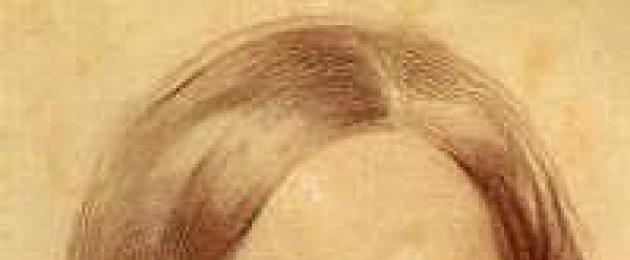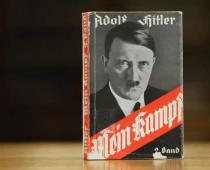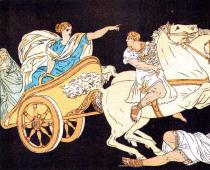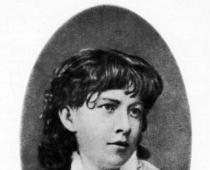The Project Gutenberg eBook, Jane Eyre, by Charlotte Bronte, Illustrated
by F. H. Townsend
This eBook is for the use of anyone anywhere at no cost and with
almost no restrictions whatsoever. You may copy it, give it away or
re-use it under the terms of the Project Gutenberg License included
with this eBook or online at www.gutenberg.org
Title: Jane Eyre
an Autobiography
Release Date: April 29, 2007
Language: English
Character set encoding: ISO-646-US (US-ASCII)
***START OF THE PROJECT GUTENBERG EBOOK JANE EYRE***
Jane Eyre, by Charlotte Bronte
Transcribed from the 1897 Service & Paton edition by David Price, email [email protected]
JANE EYRE AN AUTOBIOGRAPHY
by
CHARLOTTE BRONTË
ILLUSTRATED BY F. H. TOWNSEND
London
SERVICE & PATON
5 henrietta street
1897
The Illustrations
in this Volume are the copyright of
Service & Paton
, London
TO
W.
M. THACKERAY, Esq.
,
This Work
is respectfully inscribed
by
THE AUTHOR
PREFACE
A preface to the first edition of “Jane Eyre” being unnecessary, I gave none: this second edition demands a few words both of acknowledgment and miscellaneous remark.
My thanks are due in three quarters.
To the Public, for the indulgent ear it has inclined to a plain tale with few pretensions.
To the Press, for the fair field its honest suffrage has opened to an obscure aspirant.
To my Publishers, for the aid their tact, their energy, their practical sense and frank liberality have afforded an unknown and unrecommended Author.
The Press and the Public are but vague personifications for me, and I must thank them in vague terms; but my Publishers are definite: so are certain generous critics who have encouraged me as only large-hearted and high-minded men know how to encourage a struggling stranger; to them, i.e. , to my Publishers and the select Reviewers, I say cordially, Gentlemen, I thank you from my heart.
Having thus acknowledged what I owe those who have aided and approved me, I turn to another class; a small one, so far as I know, but not, therefore, to be overlooked. I mean the timorous or carping few who doubt the tendency of such books as “Jane Eyre:” in whose eyes whatever is unusual is wrong; whose ears detect in each protest against bigotry-that parent of crime-an insult to piety, that regent of God on earth. I would suggest to such doubters certain obvious distinctions; I would remind them of certain simple truths.
Conventionality is not morality. Self-righteousness is not religion. To attack the first is not to assail the last. To pluck the mask from the face of the Pharisee, is not to lift an impious hand to the Crown of Thorns.
These things and deeds are diametrically opposed: they are as distinct as is vice from virtue. Men too often confound them:
The Project Gutenberg eBook, Jane Eyre, by Charlotte Bronte, Illustrated
by F. H. Townsend
This eBook is for the use of anyone anywhere at no cost and with
almost no restrictions whatsoever. You may copy it, give it away or
re-use it under the terms of the Project Gutenberg License included
with this eBook or online at www.gutenberg.org
Title: Jane Eyre
an Autobiography
Release Date: April 29, 2007
Language: English
Character set encoding: ISO-646-US (US-ASCII)
***START OF THE PROJECT GUTENBERG EBOOK JANE EYRE***
Jane Eyre, by Charlotte Bronte
Transcribed from the 1897 Service & Paton edition by David Price, email [email protected]
JANE EYRE AN AUTOBIOGRAPHY
by
CHARLOTTE BRONTË
ILLUSTRATED BY F. H. TOWNSEND
London
SERVICE & PATON
5 henrietta street
1897
The Illustrations
in this Volume are the copyright of
Service & Paton
, London
TO
W.
M. THACKERAY, Esq.
,
This Work
is respectfully inscribed
by
THE AUTHOR
PREFACE
A preface to the first edition of “Jane Eyre” being unnecessary, I gave none: this second edition demands a few words both of acknowledgment and miscellaneous remark.
My thanks are due in three quarters.
To the Public, for the indulgent ear it has inclined to a plain tale with few pretensions.
To the Press, for the fair field its honest suffrage has opened to an obscure aspirant.
To my Publishers, for the aid their tact, their energy, their practical sense and frank liberality have afforded an unknown and unrecommended Author.
The Press and the Public are but vague personifications for me, and I must thank them in vague terms; but my Publishers are definite: so are certain generous critics who have encouraged me as only large-hearted and high-minded men know how to encourage a struggling stranger; to them, i.e. , to my Publishers and the select Reviewers, I say cordially, Gentlemen, I thank you from my heart.
Having thus acknowledged what I owe those who have aided and approved me, I turn to another class; a small one, so far as I know, but not, therefore, to be overlooked. I mean the timorous or carping few who doubt the tendency of such books as “Jane Eyre:” in whose eyes whatever is unusual is wrong; whose ears detect in each protest against bigotry-that parent of crime-an insult to piety, that regent of God on earth. I would suggest to such doubters certain obvious distinctions; I would remind them of certain simple truths.
Conventionality is not morality. Self-righteousness is not religion. To attack the first is not to assail the last. To pluck the mask from the face of the Pharisee, is not to lift an impious hand to the Crown of Thorns.
These things and deeds are diametrically opposed: they are as distinct as is vice from virtue. Men too often confound them:
I had some spare time last week and my mom recommended me to read some of her favourite books. They were mainly of foreign authors and I Liked many of them. But most of all I was impressed with "Jane Eyre" by Charlotte Bronte.
It is a moving love story with the happy ending, set in the Victorian England. The author tells simple and quite traditional story of a poor girl, Jane, having deep and sincere feelings to her married master, Edward Rochester. I think, Jane Eyre is one of the great romantic heroines of world literature. Being a penniless orphan, Jane, due to her personal talents, exceptional inner features and moral convictions, found her true love and happiness.
I admired everything in this book: the plot, the characters, the style and, especially, the author"s emotional honesty. Readers can find many attractions in this novel: tender heroine, self-devotion, painful separation, dark mystery, catastrophe, happy ending. Without doubt, this book is highly-prized by readers, literary critics, and researchers.
I have learned that there are twenty-two films, nine TV versions of the novel, several ballets, an opera, and a couple of musicals based on the novel "Jane Eyre". Some people would say that this story is a little bit naive for a modern reader, who is spoiled by pragmatism of our epoch. Sometimes I was irritated by the passiveness of Jane Eyre. But such involvement the reader into the plot of the novel is the mark of a true writer"s talent.
Джейн Эйр
У меня было немного свободного времени на прошлой неделе, и моя мама порекомендовала мне прочитать некоторые из своих любимых книг. Они были в основном зарубежных авторов, и мне понравилось много из них. Но больше всего я была впечатлена "Джейн Эйр" Шарлотты Бронте.
Это трогательная история любви со счастливым концом, происходящая в викторианской Англии. Автор рассказывает простой и довольно традиционный рассказ о бедной девушке, Джейн, имеющей глубокие и искренние чувства к Эдварду Рочестеру. Я думаю, что, Джейн Эйр является одной из великих романтических героинь мировой литературы. Будучи сиротой без гроша, Джейн, в связи с ее личным талантам, исключительными внутренними возможностями и моральными убеждениями, нашла настоящую любовь и счастье.
Я восхищалась всем в этой книге: сюжетом, персонажами, стилем и, особенно, эмоциональной честностью автора. Читатели могут найти много привлекательных особенностей в этом романе: нежная героиня, самоотдача, болезненные расставания, темные тайны, катастрофы, счастливый конец. Без сомнения, эта книга высоко ценится читателями, литературными критиками и исследователи
Я узнала, что есть двадцать два фильма, девять ТВ версий романа, несколько балетов, оперы, и пару мюзиклов по мотивам романа "Джейн Эйр". Некоторые люди говорят, что эта история немного наивна для современного читателя, который испорчен прагматизмом нашей эпохи. Иногда меня раздражала пассивность Джейн Эйр. Но такая вовлеченность читателя в сюжет романа - знак истинного таланта писателя.
Бронте Ш.
| Шарлотта Бронте | |
| Charlotte Brontë | |
 |
|
| Псевдонимы: |
Каррер Белл |
|---|---|
| Дата рождения: | |
| Место рождения: | |
| Дата смерти: | |
| Место смерти: | |
| Гражданство: |
Великобритания |
| Род деятельности: | |
| Язык произведений: | |
В честь Шарлотты Бронте назван кратер на Меркурии .
Ссылки
- Бронте, Шарлотта в библиотеке Максима Мошкова
Другие книги схожей тематики:
| Автор | Книга | Описание | Год | Цена | Тип книги |
|---|---|---|---|---|---|
| Бронте Ш. | Роман английской писательницы Шарлотты Бронте рассказывает о судьбе девушки из сиротского приюта. События разворачиваются в викторианской Англии в первой половине XIX века и отражают подлинные… - Айрис-Пресс, (формат: 70x90/32, 256 стр.) Классика в пересказе | 2016 | 95 | бумажная книга | |
| Бронте Шарлота | В книге представлен текст романа Шарлотты Бронте «Джейн Эйр» на английском языке. Издание входит в серию English Fiction Collection, состоящей из лучших произведений английских и американских авторов - Сибирское университетское издательство, English Fiction Collection | 2013 | 192 | бумажная книга | |
| Бронте Шарлота | В книге представлен текст романа Шарлотты Бронте Джейн Эйр на английском языке. Издание входит в серию English Fiction Collection, состоящей из лучших произведений английскихи американских авторов - Сибирское университетское издательство, (формат: 60x90/32мм, 352 стр.) English Fiction Collection | 2013 | 147 | бумажная книга | |
| Шарлотта Бронте | Чтение оригинальных произведений - простой и действенный способ погрузиться в языковую среду и совершенствоваться в иностранном языке. Серия "Бестселлер на все времена" - это возможность улучшить… - Эксмо, (формат: 84x108/32, 512 стр.) Бестселлер на все времена | 2016 | 128 | бумажная книга | |
| Шарлотта Бронте | Чтение оригинальных произведений – простой и действенный способ погрузиться в языковую среду и совершенствоваться в иностранном языке. Серия «Бестселлер на все времена» – это возможность улучшить… - Эксмо, (формат: 84x108/32, 512 стр.) Бестселлер на все времена электронная книга | 1847 | 109 | электронная книга | |
| Бронте Шарлотта | Серия "Читаю иллюстрированную классику в оригинале"-это любимые читателями произведения на языке оригинала, дополненные прекрасными иллюстрациями известных художников. С ними легко погрузиться в… - Эксмо, (формат: 60x90/32мм, 352 стр.) Читаю иллюстрированную классику в оригинале | 2017 | 584 | бумажная книга | |
| Бронте Шарлотта | История страданий и обретения счастья бедной сиротки Джен Эйр, описанная замечательной английской писательницей Шарлоттой Бронте (1816-1855), известна всем. С невзгодами и лишениями героине романа… - Каро, Чтение в оригинале. Английский язык | 2016 | 200 | бумажная книга | |
| Бронте Шарлотта | 512 стр История страданий и обретения счастья бедной сиротки Джен Эйр, описанная замечательной английской писательницей Шарлоттой Бронте (1816-1855), известна всем. С невзгодами и лишениями героине… - КАРО, (формат: 70x100/32, 512 стр.) Classical literature |

Шарлотта Бронте «Джейн Эйр» на английском языке
The novel begins with the titular character, Jane Eyre, aged 10, living with her maternal uncle’s family, the Reeds, as a result of her uncle’s dying wish. It is several years after her parents died of typhus. Mr. Reed, Jane’s uncle, was the only one in the Reed family who was kind to Jane. Jane’s aunt, Sarah Reed, dislikes her, treats her as a burden, and discourages her children from associating with Jane. Mrs. Reed and her three children are abusive to Jane, physically, emotionally, and, as the reader is quick to realize, spiritually. The nursemaid Bessie proves to be Jane’s only ally in the household, even though Bessie sometimes harshly scolds Jane. Excluded from the family activities, Jane is incredibly unhappy, with only a doll and books in which to find solace.
One day, after her cousin John knocks her down and she attempts to defend herself, Jane is locked in the red room where her uncle died; there, she faints from panic after she thinks she has seen his ghost. She is subsequently attended to by the kindly apothecary, Mr. Lloyd, to whom Jane reveals how unhappy she is living at Gateshead Hall. He recommends to Mrs. Reed that Jane should be sent to school, an idea Mrs. Reed happily supports. Mrs. Reed then enlists the aid of the harsh Mr. Brocklehurst, director of Lowood Institution, a charity school for girls. Mrs. Reed cautions Mr. Brocklehurst that Jane has a «tendency for deceit», which he interprets as her being a «liar». Before Jane leaves, however, she confronts Mrs. Reed and declares that she’ll never call her «aunt» again, that Mrs. Reed and her daughter, Georgiana, are the ones who are deceitful, and that she’ll tell everyone at Lowood how cruelly Mrs. Reed treated her.
At Lowood Institution, a school for poor and orphaned girls, Jane soon finds that life is harsh, but she attempts to fit in and befriends an older girl, Helen Burns, who is able to accept her punishment philosophically. During a school inspection by Mr. Brocklehurst, Jane accidentally breaks her slate, thereby drawing attention to herself. He then stands her on a stool, brands her a liar, and shames her before the entire assembly. Jane is later comforted by her friend, Helen. Miss Temple, the caring superintendent, facilitates Jane’s self-defence and writes to Mr. Lloyd, whose reply agrees with Jane’s. Jane is then publicly cleared of Mr. Brocklehurst’s accusations.
The 80 pupils at Lowood are subjected to cold rooms, poor meals, and thin clothing. Many students fall ill when a typhus epidemic strikes, and Jane’s friend Helen dies of consumption in her arms. When Mr. Brocklehurst’s maltreatment of the students is discovered, several benefactors erect a new building and install a sympathetic management committee to moderate Mr. Brocklehurst’s harsh rule. Conditions at the school then improve dramatically.
The name Lowood symbolizes the «low» point in Jane’s life where she was maltreated. Helen Burns is a representation of Charlotte’s elder sister Maria, who died of tuberculosis after spending time at a school where the children were mistreated.
After six years as a student and two as a teacher at Lowood, Jane decides to leave, like her friend and confidante Miss Temple, who recently married. She advertises her services as a governess and receives one reply, from Alice Fairfax, housekeeper at Thornfield Hall. Jane takes the position, teaching Adèle Varens, a young French girl.
One night, while Jane is walking to a nearby town, a horseman passes her. The horse slips on ice and throws the rider. Despite the rider’s surliness, Jane helps him to get back onto his horse. Later, back at Thornfield, she learns that this man is Edward Rochester, master of the house. Adèle is his ward, left in his care when her mother abandoned her.
At Jane’s first meeting with him within Thornfield, Mr. Rochester teases her, accusing her of bewitching his horse to make him fall. He also talks strangely in other ways, but Jane is able to give as good as she gets. Mr. Rochester and Jane soon come to enjoy each other’s company, and spend many evenings together.
Odd things start to happen at the house, such as a strange laugh, a mysterious fire in Mr. Rochester’s room (from which Jane saves Rochester by rousing him and throwing water on him and the fire), and an attack on a house guest of Rochester’s, a Mr. Mason. Then Jane receives word that her aunt Mrs. Reed is calling for her, after suffering a stroke because her unruly son John has died in sad circumstances. Jane returns to Gateshead and remains there for a month, attending to her dying aunt. As she lies dying, Mrs. Reed confesses to Jane that she has wronged her, and gives Jane a letter from Jane’s paternal uncle, Mr. John Eyre, in which he asks for her to live with him and be his heir. Mrs. Reed admits to telling Mr. Eyre that Jane had died of fever at Lowood. Soon afterward, Jane’s aunt dies, and Jane helps her cousins after the funeral before returning to Thornfield.
Back at Thornfield, Jane broods over Mr. Rochester’s rumoured impending marriage to the beautiful and talented, but snobbish and heartless, Blanche Ingram. However, one midsummer evening, Rochester baits Jane by saying how much he will miss her after getting married, but how she will soon forget him. There then follows one of the most stirring speeches in the whole book, when the normally self-controlled Jane opens her heart to him. Rochester is then sure that Jane is sincerely in love with him, and he proposes marriage. Jane is at first sceptical of his sincerity, but eventually believes him and gladly agrees to marry him. She then writes to her Uncle John, telling him of her happy news.
As she prepares for her wedding, Jane’s forebodings arise when a strange, savage-looking woman sneaks into her room one night and rips her wedding veil in two. As with the previous mysterious events, Mr. Rochester attributes the incident to Grace Poole, one of his servants. During the wedding ceremony, Mr. Mason and a lawyer declare that Mr. Rochester cannot marry because he is still married to Mr. Mason’s sister, Bertha. Mr. Rochester admits this is true but explains that his father tricked him into the marriage for her money. Once they were united, he discovered that she was rapidly descending into madness, and so he eventually locked her away in Thornfield, hiring Grace Poole as a nurse to look after her. When Grace gets drunk, his wife escapes and causes the strange happenings at Thornfield.
It turns out that Jane’s uncle, Mr. John Eyre, is a friend of Mr. Mason’s and was visited by him soon after Mr. Eyre received Jane’s letter about her impending marriage. After the marriage ceremony is broken off, Mr. Rochester asks Jane to go with him to the south of France, and live with him as husband and wife, even though they cannot be married. Refusing to go against her principles, and despite her love for him, Jane leaves Thornfield in the middle of the night.
Jane travels as far from Thornfield as she can using the little money she had previously saved. She accidentally leaves her bundle of possessions on the coach and has to sleep on the moor, and unsuccessfully attempts to trade her handkerchief and gloves for food. Exhausted and hungry, she eventually makes her way to the home of Diana and Mary Rivers, but is turned away by the housekeeper. She collapses on the doorstep, preparing for her death. St. John Rivers, Diana and Mary’s brother and a clergyman, saves her. After she regains her health, St. John finds Jane a teaching position at a nearby village school. Jane becomes good friends with the sisters, but St. John remains aloof.
The sisters leave for governess jobs, and St. John becomes somewhat closer to Jane. St. John learns Jane’s true identity and astounds her by telling her that her uncle, John Eyre, has died and left her his entire fortune of 20,000 pounds (equivalent to over £1.3 million in 2011 ). When Jane questions him further, St. John reveals that John Eyre is also his and his sisters’ uncle. They had once hoped for a share of the inheritance but were left virtually nothing. Jane, overjoyed by finding that she has living and friendly family members, insists on sharing the money equally with her cousins, and Diana and Mary come back to Moor House to live.
Proposals
Thinking Jane will make a suitable missionary’s wife, St. John asks her to marry him and to go with him to India, not out of love, but out of duty. Jane initially accepts going to India but rejects the marriage proposal, suggesting they travel as brother and sister. As soon as Jane’s resolve against marriage to St. John begins to weaken, she mysteriously hears Mr. Rochester’s voice calling her name. Jane then returns to Thornfield to find only blackened ruins. She learns that Mr. Rochester’s wife set the house on fire and committed suicide by jumping from the roof. In his rescue attempts, Mr. Rochester lost a hand and his eyesight. Jane reunites with him, but he fears that she will be repulsed by his condition. «Am I hideous, Jane?», he asks. “Very, sir: you always were, you know”, she replies. When Jane assures him of her love and tells him that she will never leave him, Mr. Rochester again proposes, and they are married. He eventually recovers enough sight to see their first-born son.







